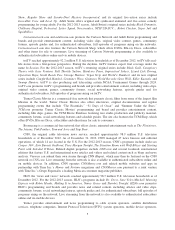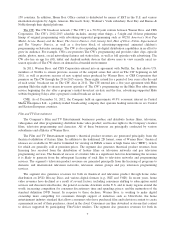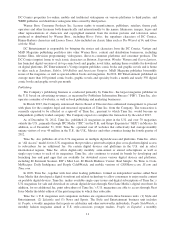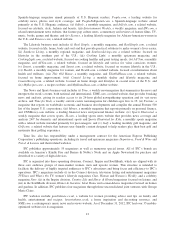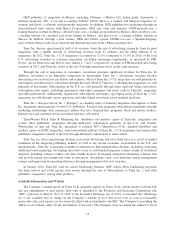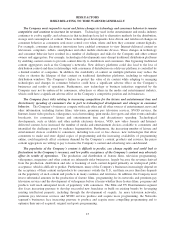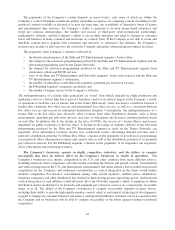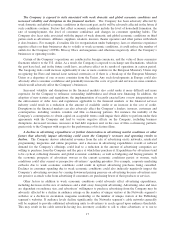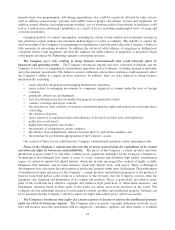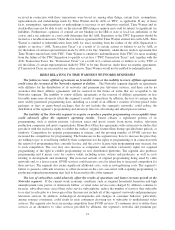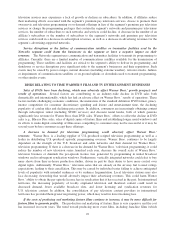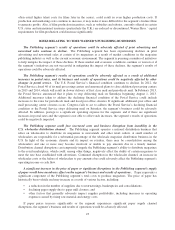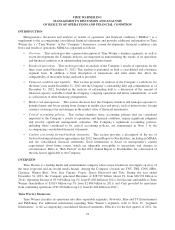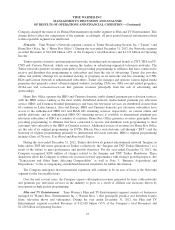Time Magazine 2012 Annual Report Download - page 31
Download and view the complete annual report
Please find page 31 of the 2012 Time Magazine annual report below. You can navigate through the pages in the report by either clicking on the pages listed below, or by using the keyword search tool below to find specific information within the annual report.RISK FACTORS
RISKS RELATING TO TIME WARNER GENERALLY
The Company must respond to recent and future changes in technology and consumer behavior to remain
competitive and continue to increase its revenues. Technology used in the entertainment and media industry
continues to evolve rapidly, and advances in that technology have led to alternative methods for the distribution,
storage and consumption of content. These technological developments have driven and reinforced changes in
consumer behavior as consumers seek more control over when, where and how they consume content digitally.
For example, consumer electronics innovations have enabled consumers to view Internet-delivered content on
televisions, computers, tablets, smartphones and other mobile electronic devices. These changes in technology
and consumer behavior have resulted in a number of challenges and risks for the Company and other content
owners and aggregators. For example, technological developments may disrupt traditional distribution platforms
by enabling content owners to provide content directly to distributors and consumers, thus bypassing traditional
content aggregators such as the Company’s networks. New delivery platforms could also lead to the loss of
distribution control and direct relationships with consumers if distribution on a delivery platform is controlled by
a limited number of companies. In addition, the availability of content on multiple platforms may reduce the
value or shorten the lifespan of that content on traditional distribution platforms, including in subsequent
distribution windows. The Company’s failure to protect the value of its content while adapting to emerging
technologies and changes in consumer behavior could have a significant adverse effect on the Company’s
businesses and results of operations. Furthermore, new technology or business initiatives supported by the
Company may not be embraced by consumers, advertisers or others in the media and entertainment industry,
which could have a significant adverse effect on the Company’s competitive position and its businesses.
The Company faces risks relating to increasing competition for the leisure and entertainment time and
discretionary spending of consumers due in part to technological developments and changes in consumer
behavior. The Company’s businesses compete with each other and all other sources of entertainment, news and
other information, including feature films, television, premium pay television services, SVOD services, the
Internet, home video products, videogames, social networking, print media, live sports and other events and radio
broadcasts, for consumers’ leisure and entertainment time and discretionary spending. Technological
developments, such as tablets and other mobile electronic devices, VOD, new video formats and Internet-
delivered content, have increased the number of media and entertainment choices available to consumers and
intensified the challenges posed by audience fragmentation. Furthermore, the increasing number of leisure and
entertainment choices available to consumers, including low-cost or free choices, new technologies that allow
consumers to make and store digital copies of programming and the increasing availability of programming
online, could negatively affect consumer demand for the Company’s content, products and services, the prices
content aggregators are willing to pay to license the Company’s content and advertising rates and demand.
The popularity of the Company’s content is difficult to predict, can change rapidly and could lead to
fluctuations in the Company’s revenues, and low public acceptance of the Company’s content may adversely
affect its results of operations. The production and distribution of feature films, television programming,
videogames, magazines and other content are inherently risky businesses, largely because the revenues derived
from the production, distribution and sale or licensing of such content depend primarily on widespread public
acceptance, which is difficult to predict. Furthermore, many of the Company’s businesses increasingly depend on
the acceptance of their content and products by consumers outside the U.S., and their success therefore depends
on the popularity of such content and products in many countries and territories. In addition, the Company must
invest substantial amounts in the production of feature films, programming for its networks and premium pay
television services and the development of videogames before it learns whether these feature films, programs and
products will reach anticipated levels of popularity with consumers. The Film and TV Entertainment segment
also faces increasing pressure to develop successful new franchises or build on existing brands by leveraging
existing intellectual property, including through the development of sequels. As more television networks,
premium pay television services and SVOD services produce and acquire more programming, the Networks
segment’s businesses face increasing pressure to produce and acquire more compelling programming and to
optimize their mix of acquired, original and sports programming.
15


